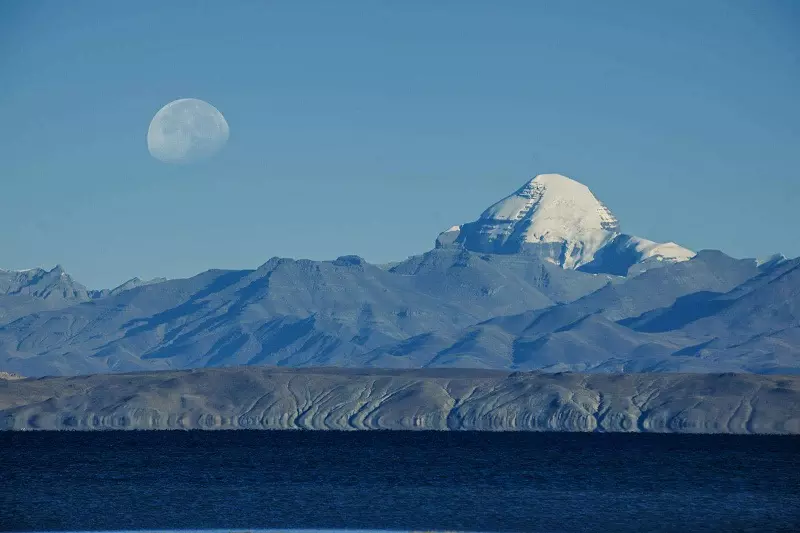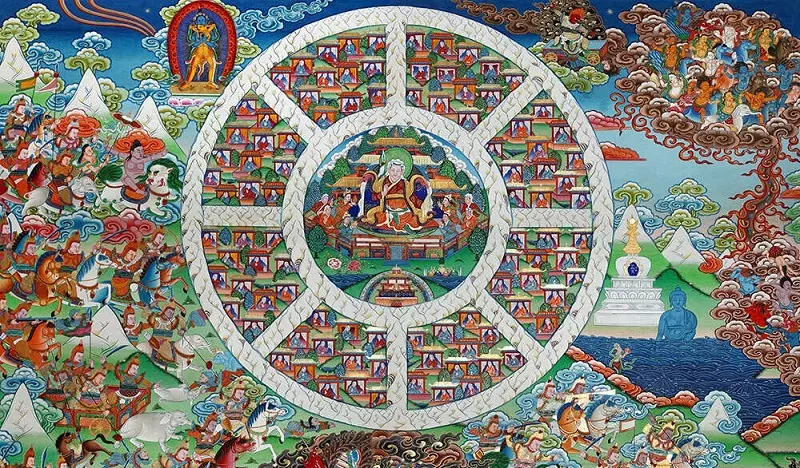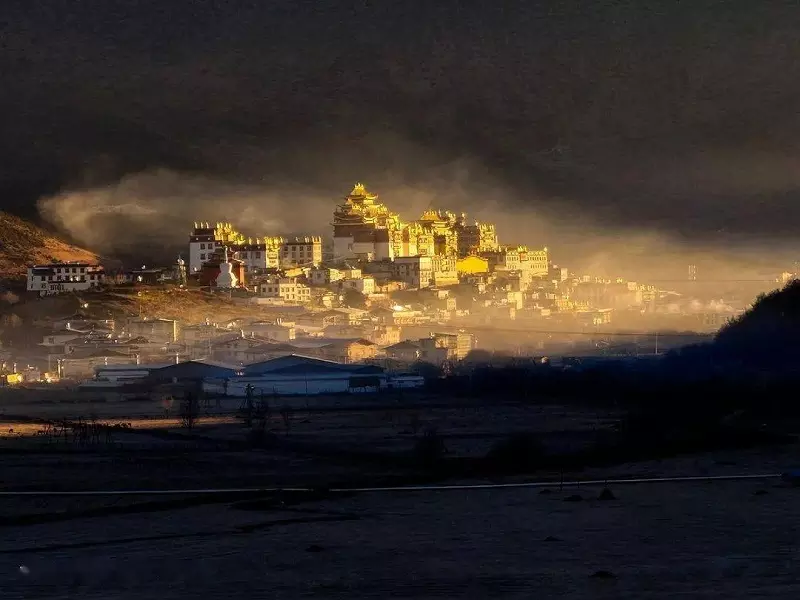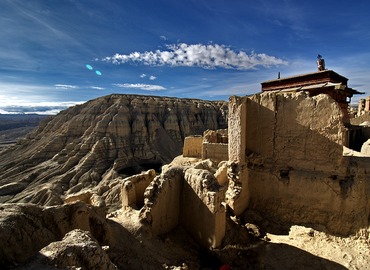Shambhala: Mystical Utopia of Tibetan Buddhism
- Emily
- Last Updated : 07/15/2025
Shambhala is a transliteration of a Tibetan word, also known as "Shangri-La," which means "ultimate paradise." It is a legendary utopia and the origin of the Kalachakra Tantra, said to be a real pure land on Earth as recorded in Buddhist scriptures. This mysterious place is an ideal paradise for Buddhists and a dream destination for explorers and believers.
Where is Shambhala
The eminent monks of various sects of Tibetan Buddhism all believe: "Somewhere near the main peak of the Gangdise Mountains, there is a mysterious place called "Shambhala". In the writings of the Tibetan scholar Awang Pandita, Shambhala is a mandala. It is shaped like a giant eight-petaled lotus, with each petal representing an administrative district. Each district contains 120 million villages, and the entire perimeter of Shambhala is surrounded by insurmountable snow mountains. At the center of Shambhala is its capital, Kalapa, where the king resides in a palace made of gold, silver, turquoise, coral, and pearls.
The king is the incarnation of Vajrapani Bodhisattva. The palace emits a soft glow from within, illuminating the surroundings so that day and night are indistinguishable. To the south of the palace lies a beautiful garden, which houses the temples of the Time God Kalachakra and the Time Goddess Vishvamata. The city also has a Sun Temple and a Moon Temple. The inhabitants of Shambhala follow the Kalachakra Tantra and lead prosperous and happy lives, free from poverty, disease, death, and war. They enjoy the blessings and protection of Amitabha.

The Origin and Legend of Shambhala
Shambhala originates from the Kalachakra Tantra. This scripture is said to have been personally taught by Buddha Shakyamuni to Suchandra, the King of Shambala. The teachings were later brought to Tibet by Padmasambhava, and translated into Tibetan.
The original text of the Kalachakra Tantra consisted of 12,000 verses, but its manuscript has been lost. What remains today is a condensed version. According to the time calculations, Shakyamuni Buddha met King Suchandra and his 96 subordinates in 878 BCE. The meeting took place near Dhanyakataka, in the vicinity of Rajagriha's Vulture Peak in southern India.
When King Suchandra requested esoteric tantras, the Buddha transformed into the Time God Kalachakra, surrounded by bodhisattvas, and delivered the tantras from a lion throne. After receiving the esoteric initiation, King Suchandra returned to Shambhala and established Tibetan Buddhism as the state religion. Based on his memory, he wrote the original text of the Kalachakra Tantra and added many annotations. His successor, Manjushrikirti, condensed the original text into the Kalachakra Laghutantra, comprising 1,000 verses, which has been fully preserved to this day.
In Tibetan Buddhism, Suchandra is considered an incarnation of the bodhisattva Vajrapani, and the location of his kingdom remains a mystery. For centuries, Tibetan lamas have provided ambiguous answers for the existence of Shambhala. According to Tibetan Buddhist teachings, Shambhala is primarily a spiritual realm that can only be accessed by those who have received initiation of Kalachakra. The only known address of Shambhala is beyond the river Sitha, but this river cannot be found on any map. Over the centuries, seekers of Shambhala have explored areas between Kashmir and the Arctic, often focusing on the Tarim Basin region. Some lamas claim that the kingdom of Shambhala still exists there, but it is concealed by a magical barrier that renders it invisible to outsiders.

Exploring Shangri-La
The first expedition to search for Shangri-La was led by Nicholas Roerich from March 1925 to May 1928. Roerich's team, consisting of over twenty members, sought support from two high-ranking Soviet officials before their departure. At that time, the Soviets were captivated by the Shangri-La legend, hoping to find advanced technologies there to create a super army.
In May 1925, the expedition arrived in a small Himalayan town called Darjeeling, where they interacted with local Tibetans to gather useful information. In August 1927, they entered Tibet again but mysteriously disappeared on the Changtang Plateau. It was widely speculated that they had perished, but in May 1928, the team reappeared in Moscow without having found the entrance to Shangri-La. However, Roerich never spoke of the mission again.
Between 1938 and 1943, Germany sent two expeditions to search for evidence of Aryan ancestors in Atlantis. What’s more, they aim to find the "Earth Axis World" which is capable of altering time and creating an immortal army. Upon reaching Tibet, anthropologist Bruno Beger measured Tibetan skulls, compared their hair with other ethnicities, and examined their eye colors. Local Tibetans mentioned a cave called Shambhala, filled with infinite energy and gold, which was roughly located at Mount Kailash. The German team returned in August of the following year with extensive research data, classified as top secret by Germany. Subsequently, experts in the USSR and USA linked Germany's advanced rocket, missile, and aircraft engine technologies to these Tibetan explorations.
In 1951, a British mountaineer Eric Shipton discovered a series of humanoid footprints while climbing Mount Everest, causing quite a stir. The footprints were notably large, measuring about 13 inches (33 cm) in length. This discovery sparked a Western craze for finding the Yeti, believed to be the key to Shangri-La's entrance. The Yeti's footprints often disappear and appear suddenly, suggesting either flying or access to another dimension. So the yeti may not be a creature of our surface world, aligning with Tibetan legends of deities and mountain spirits with such abilities.
In 1963, Tibetan monk Tulshuk Lingpa set out with 12 disciples on a journey to find the entrance to Shangri-La. He had earlier been bestowed the title "Lingpa,” meaning an exceptional tertön—a revealer of hidden spiritual treasures in Tibetan Buddhism, known as terma, meant to be discovered by destined individuals. During deep meditation, Tulshuk received a vision from a dakini, revealing that he was the prophesied monk destined to open the gateway to Shangri-La, believed to lie in the Kanchenjunga region of Sikkim.
In early spring, following the guidance from his visions, Tulshuk and his disciples reached a cave halfway up a glacier. Harsh weather trapped them for 19 days. Eventually, Tulshuk took one disciple to scout ahead. Upon reaching the summit, they witnessed lush green forests, celestial music, and tall, otherworldly beings—scenery unlike anything from the known world.
He stopped his disciple from entering, intending to return with the entire group. But during their second ascent, an avalanche struck. Tulshuk was later found seated in meditation, unharmed, his face serene in death. Some esteemed monks later believed that the group's collective merit was not yet sufficient to enter the sacred realm.
This journey remains one of the most legendary and closest approaches to the mythical Shangri-La ever recorded.
Possible Places of Shambala
In the search for Shambala, many beautiful and mystical places have been discovered, each bearing characteristics similar to those descriptions. The locations are considered the most famous candidates as follows:
* Shangri-La City in Diqing Prefecture: Originally known as Zhongdian County, this county-level city in Yunnan Province was renamed Shangri-La in 2001. It is believed to be the prototype for James Hilton's Lost Horizon because its valley closely resembles the one described in the novel.

* Mount Kailash in Purang Town, Tibet: Known as a sacred mountain for four religions, Mount Kailash is often referred to as the center of the world. Legends claim that Shambhala, the mythical kingdom, has the axis of the Earth located beneath the pyramid-shaped Mount Kailash. It is said that turning this axis in the opposite direction could reverse time.
* Daocheng Yading in Ganzi Prefecture: Located in Sichuan Province, this nature reserve is known as the "last pure land on earth" in China. It is considered a candidate for the location of Shambhala due to its fit with descriptions in Tibetan Buddhist scriptures The area features three sacred mountains, multicolored lakes, and vast yak pastures.
* Sikkim: A small state in northeastern India, nestled in the Himalayas. It was identified by Tibetan monk Tulshuk Lingpa as one of the possible locations of Shambhala. Based on his interpretation of prophecies from his master Dorje Drolchen and the Kalachakra Tantra, Tulshuk believed that this region matched the description of the legendary gateway to Shambhala.
Conclusion
Not everyone believes in the actual existence of Shambhala. Some view it as a fictional paradise, an ideal land sought after by Tibetan Buddhists. Others see it as a symbol representing the highest state of human consciousness, a spiritual haven. However, the legend of Shambhala has inspired many across various fields, including religion, literature, art, and exploration.
Email response within 0.5~24 hours.






